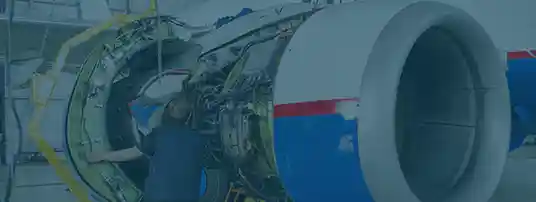Posted on April 12, 2022 linda strong jet engines
Aircraft engines, particularly turbine and high-performance piston types, often operate at very high rotational speeds to maximize thermal efficiency and power-to-weight ratios. However, when such engines drive propellers, a challenge arises. Propellers are only aerodynamically efficient within a limited RPM range, and if they approach or exceed transonic speeds - typically around 1,100 to 1,150 feet per second at sea level - shock waves can form. This phenomenon, known as compressibility or transonic drag, leads to reduced thrust, increased aerodynamic drag, excessive noise, and elevated mechanical stress on the propeller system.
To resolve this issue, many aircraft employ a reduction gearbox (RGB). This mechanical system decouples the engine’s high RPM from the propeller’s rotation, allowing the engine to operate in its optimal speed range while keeping the propeller within its own efficiency envelope. In this blog, we will discuss three primary reduction gear system configurations used to illustrate how each design supports specific performance requirements.
Spur planetary gearing forms the basis for many turboprop gearbox designs. Common in high-powered piston aircraft, its appeal lies in its ability to efficiently distribute torque, dampen vibration, and facilitate high-load operation through multiple gear engagements. This configuration functions through:
As the crankshaft rotates the sun gear, the planetary gears orbit within the system, causing the propeller shaft to turn in the same direction at a reduced speed.
For some designs, the bell gear may sometimes be mounted to the propeller shaft while the carrier is fixed, which results in the propeller rotating in the opposite direction of the crankshaft. Meanwhile, turboprop engines require multi-stage spur planetary gearboxes to accommodate the extreme speed differential between components. While gas turbines operate at 10,000 to 30,000 RPM, propellers must stay within the 1,000 to 2,000 RPM range. As such, these multi-stage systems enable the high reduction ratios needed while upholding torque balance and mechanical stability under high loads.
Bevel planetary systems make use of angled gear teeth to accommodate constrained engine nacelles or auxiliary systems. With this setup:
To support these interactions, a thrust ball bearing is used to handle the axial loads produced by the beveled gear geometry, while heavy-duty ball bearings stabilize the drive and stationary gear assemblies. This configuration is favored for its space-saving layout, smooth torque transfer, and moderate speed reduction, which all make it well-suited for smaller turboprops and compact installations where other variants would be more impractical.
In spur and pinion reduction gearing, a small pinion gear mounted on the crankshaft meshes directly with a larger spur gear connected to the propeller shaft. The gear ratio between these two components provides the necessary reduction in propeller speed relative to engine RPM.
Although it lacks the torque distribution, vibration damping, and load-spreading benefits of planetary systems, spur and pinion gearing serves as a cost-effective, lightweight solution for low-power engines, such as those used in light general aviation aircraft applications. Moreover, its mechanical simplicity makes it easier to manufacture and maintain, contributing further to its use in simpler engine architectures.
Due to the high mechanical demands placed on reduction gear assemblies, particularly during takeoff and rapid throttle changes, their internal components are generally made from forged steel. This material is chosen for its superior grain structure, which enhances toughness, fatigue resistance, and dimensional stability under thermal and mechanical loads.
Furthermore, the bearings employed in these systems are manufactured to meet stringent aerospace standards. M50 tool steel is regularly used for its high hardness, thermal resistance, and fatigue strength, while 440C stainless steel offers excellent corrosion resistance and durability. In all, these materials help ensure a long service life for reduction gear setups under the extreme operating conditions typical of aircraft propulsion systems.
As we have established, reduction gearing is imperative for the functionality of turboprop engine and piston aircraft. To keep these systems in top-notch condition, ASAP Semiconductor is proud to offer customers access to a wide range of quality parts through our streamlined procurement platform, Aviation Sourcing Solutions. With our inventory items being strictly sourced from leading global manufacturers and vetted for compliance, we make it easy for professionals to meet specific operational demands with confidence.
Moreover, with hands-on customer service, streamlined quotation processes, and curated solutions, we reduce sourcing complexity and are dedicated to helping accommodate even the most unique needs. Keeping our various commitments in mind, we encourage you to start your procurement journey and explore Aviation Sourcing Solutions today.

 The only independent
The only independent



“We Proudly Support Intrepid Fallen Heroes Fund that serves United States Military Personal experiencing the Invisible Wounds of War : Traumatic Brain Injury (TBI) and Post Traumatic Stress (PTS). Please visit website (www.fallenheroesfund.org) and help in their valiant effort”.
We Hope that You Will Visit Us Again the Next Time You Need Aircraft Parts and Make Us Your Strategic Purchasing Partner.
Request for Quote